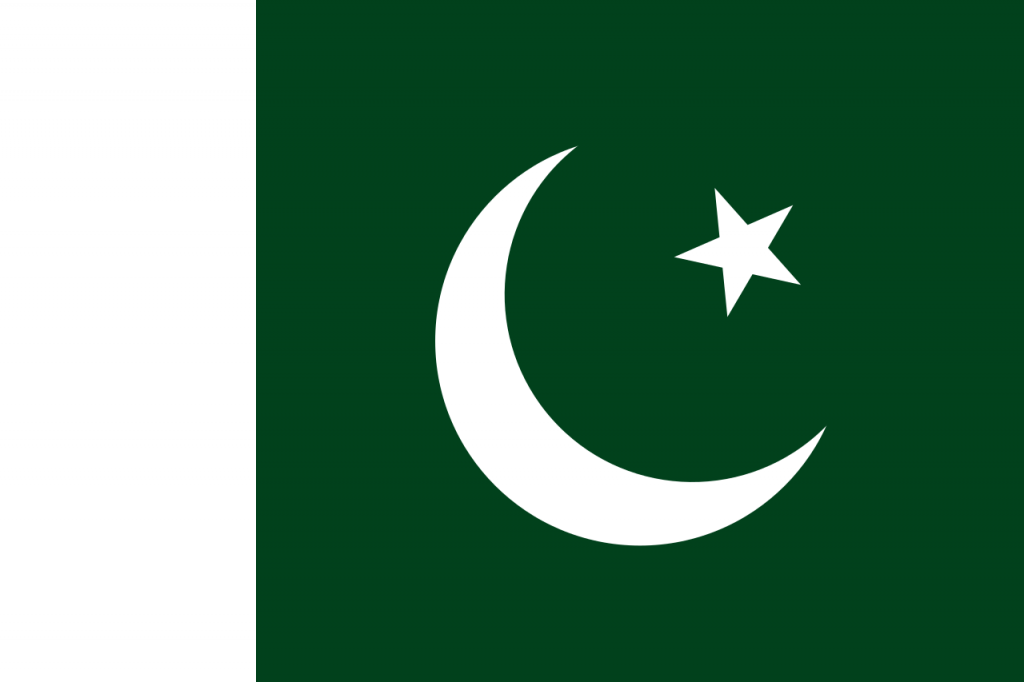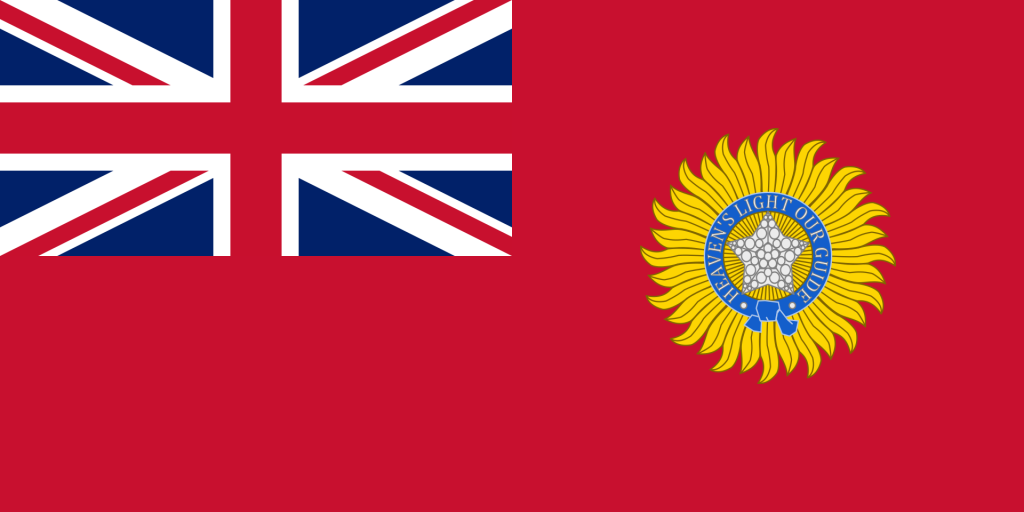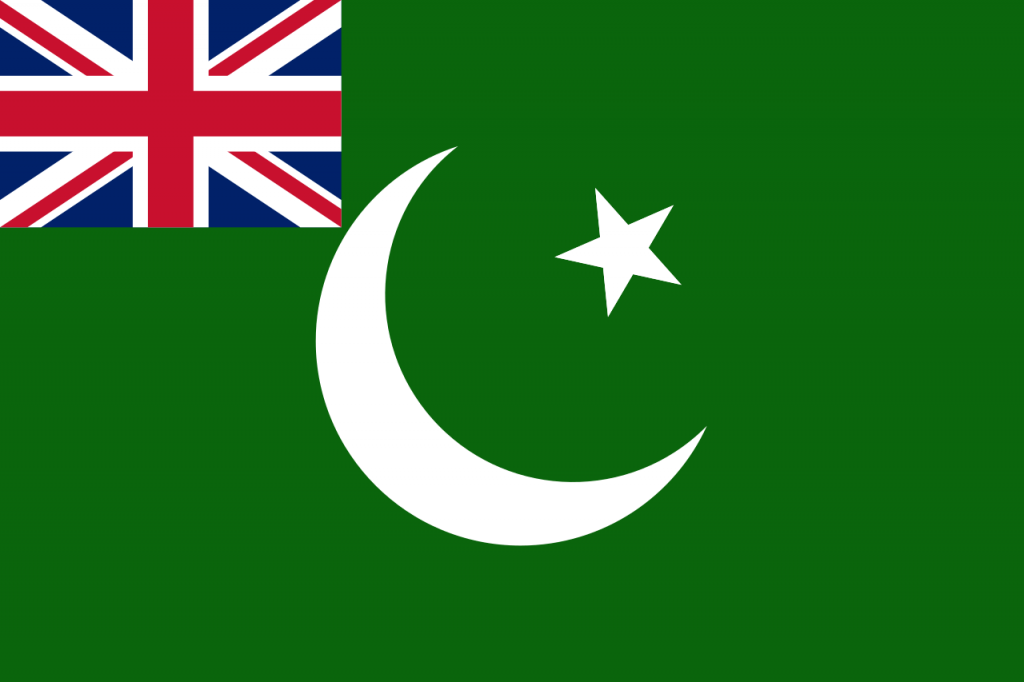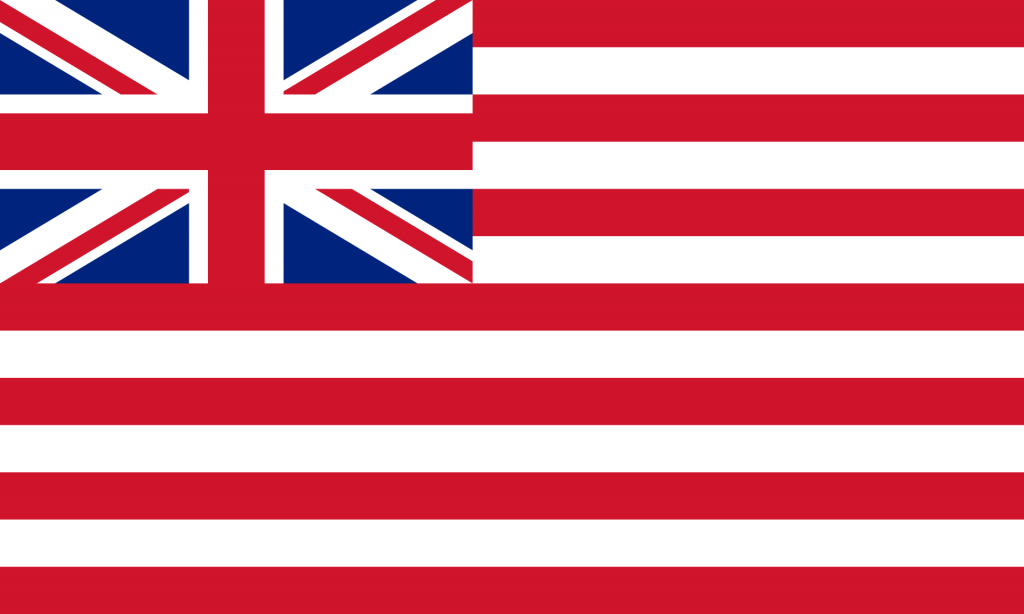With a population of a quarter billion, a rich interesting history and vibrant culture, the Islamic Republic of Pakistan is a country people really shouldn’t overlook. Hanging out next to its billion-plus population eastern neighbour India and more headline-catching western neighbour Afghanistan, it may sometimes get overlooked. What do you actually know about Pakistan, aside from it once being part of India? A good way to learn is to take a look at the flag of Pakistan, what it represents, where it came from and even some of its older versions. So that’s what we’re doing now, this is our YPT guide to the Pakistani flag.
Current Flag of Pakistan

So this is the present-day flag of Pakistan. It’s been the flag ever since it became a British dominion in 1947, remaining after full independence in 1956. The flag was designed by prominent Pakistani nationalist and political leader Syed Amir-uddin Kedwaii, who held many high positions in pro-independence parties during the years of British occupation. So let’s break down what it actually means and represents.
There’s only two colours in use here. A shade of green commonly called ‘Pakistan Green’, owing to its uniqueness, along with white. There’s both a white crescent moon with star and a white bar on the left-side of the flag. To start off with the green, this is mainly to represent the Muslim majority of the region. A key reason for the split between India and Pakistan was religious demographics, with most Hindus remaining in what became India, while many Muslims migrated to the majority-Muslim region of Pakistan. Green has long been a symbol of Islam, particularly Sunni Islam which is the predominant faith in the region.
The white meanwhile represents Pakistan’s religious minority groups, including Christians, Hindus, Sikhs and many others. The symbolism of the Pakistani flag clearly gives Islam predominance, recognizing Pakistan as a majority Muslim and Islamic influenced nation, but one that considers its minority groups an integral part of the nation. This makes sense for a flag Kedwaii designed, having been prominent in the All-India Muslim League during British colonial rule. As a matter of fact, this flag is heavily inspired by that of the All-India Muslim League, the only difference being the absence of the white stripe and a different shade of green.
Now we get to the crescent and star. The crescent moon and star has long been a prominent symbol of Islam, appearing today on the flags of many Islamic nations. This design in particular takes influence from the Ottoman Empire, whose flag can still be seen today in modern Turkey. The official stated meaning is that the crescent represents progress, while the five-pointed star symbolizes ‘light and progress’, while together it’s a reinforcement of Pakistan’s Islamic nature. The flag of Pakistan places particular emphasis on this owing to its history of partitioning from India on that religious basis.
Ensign of the British Raj

So technically speaking, this isn’t the Pakistani flag, it’s certainly not how Pakistanis, Indians and the British saw it. Nonetheless, it’s the flag that often flew over Pakistan from 1880-1947. Britain typically just flew the Union flag, sometimes with that emblem in the centre (which we’ll get to), but it was the red civil ensign that often represented the British Raj internationally, including the declaration by the United Nations during WW2. In many ways, this was the specific flag of Pakistan, India and Bangladesh at this time.
So, to get into it. We know very well what the flag in the top-left corner is, it’s just the flag of Britain. In British colonies, often they’d distinguish territory with a unique flag that just so happens to have a mini-British flag in the corner, as can still be seen today in the likes of Australia. In this case, what we’re looking at is just the civil ensign, while a blue version made up the naval ensign of the British Raj. It’s the red one that took on a life of its own as a symbol of India (and Pakistan) separate from the British flag.
Now, the unique part of this. That emblem on the right-hand side of the flag. This is the symbol of the ‘Order of the Star of India‘, an order of knighthood which decorated the chest of the British ruler put in charge of the Raj. It’s a depiction of a real medal, so the strange circles filling up the star are representative of the diamonds that studded the real thing. The yellow ‘leaves’ are meant to depict a starburst, with twenty-six small rays and twenty-six large rays alternating in a circle around the star, to show its illuminating light.
The blue ribbon illustrates this idea further. “Heaven’s Light Our Guide” The motto of the order of knighthood, chosen to have several meanings to appease the many religious groups in India at this time. Heaven is not specifically a Christian idea, so Muslims could get on-board with the idea of following Heaven’s light, though Hinduism has no such concept. In this case, the double-meaning comes into play, where ‘the heavens’ refers to the sky, specifically the stars in the sky whose light guides the way of travellers. This allowed the British to allude towards their Christian values without necessarily imposing them on the Indian population.
Imposing their own imagery onto the dominions of the British Empire has always been a classic move. For another example, we can look at what the then-Viceroy of India proposed for the flag of Pakistan at the time it was still technically part of Britain…
Mountbatten’s Proposed Flag of Pakistan (1947)

Personal opinion here, this is just terrible. Even ignoring the choice to force a British flag onto the Pakistani one, bare few millimetres of space between the crescent and the corner of the flag just looks shoddy. At least the flags of Australia, New Zealand and other commonwealth countries using this pattern had colours that lined up nicely with the British one, the sharp break between the reds and blues into the green of the main flag just looks awful!
This was the proposal of British Viceroy of India Louis Mountbatten, who had the same idea of cramming a British flag into the corner of the Indian flag as well. Both were rejected, of course. In India, it was felt that nationalist sentiment would reject this flag, but in Pakistan, it was more religious feeling that justified its exclusion. Governor-General and leader of the All-India Muslim League Muhammad Ali Jinnah rejected this design as the St George’s Cross prominent in the British flag clashed with the crescent and star, undermining the Islamic nature of Pakistan. Notably, it was essentially just his party’s flag with a British one in the corner. Just lazy.
Ultimately, the current flag was quickly adopted instead. The shade of green was darkened somewhat, presumably to set it apart, then the white stripe was added so as to recognize the minority groups that made up a portion of Pakistan’s population. Nine years later, independence was granted and this became the sole flag of Pakistan. Though they did keep the idea of having it in the corner on a red background for their own civil ensign. There is at least one more flag worth mentioning…
Flag of the British East India Company (1757-1858)

In times before direct British rule, India and at least parts of Pakistan instead fell under the colonial authority of the British East India Company. As you might guess by the name, the focus of the company was on India’s east, though gradually this power moved westwards towards Pakistan. It likely wasn’t until the early 1800s that rule over Pakistani territory was formalized and it certainly never controlled the whole territory, but its creeping expansion made it, at least for a time, a flag of Pakistan.
The East India Company was of course, not an actual nation, but rather a business based in Britain that decided to set up its own colonial rule in India. Its capital was in Calcutta, they had their own governor-general and of course, they flew their flag. With their own military power, they sometimes annexed territory outright while other times, they made deals with local leaders that allowed for ‘autonomy’ with major exceptions for the company’s financial interests.
From exploiting the natural resources of the region to building factories and flooding them with low-paid Indian and Pakistani workers, the East India Company rapidly became the wealthiest company in the entire world. In territory they directly controlled, the function of the company was akin to any other state. They had courts, taxes, education, infrastructure projects and much more, a great deal of it directly imported from Britain. But at its heart, the interests of the East India Company wasn’t state-building, it was profit.
In 1857, a wide-scale popular Indian revolt occurred against the exploitative practices of the East India Company. This upset the colonial power itself, which signed the Government of India Act in 1858, dissolving the East India Company and bringing the territory under direct rule through the British Raj. The flag came down, a new one went up and tensions long remained. It was only a matter of time before this final attempt at foreign control of the region collapsed and the flag of Pakistan could rise over the land.
That about sums up the flag of Pakistan! We could go back further, but that’s discussing mainly earlier empires with less direct connection to the modern nation. There’s only one true Pakistani flag and this is it. If you’re interested in learning more about this fascinating nation and perhaps seeing it for yourself, you can check out the tours we run there right here!





